Aldwell-Schachter Chapter 15
Click on a musical example for playback
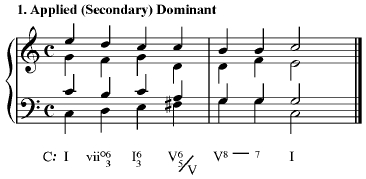
The chord on the 4th beat of measure 1 can be understood only in the context of the following chord. If we think momentarily in G Major (instead of C Major), we can see that the chord is actually a V6/5, with the following chord acting as “I” to which that chord resolves. Such a chord is called an applied chord, in that its function is applied to chords other than the original tonic. Thus the analysis of the chord as “V6/5 of V”, followed by V.
NOTE: Aldwell-Schachter use a non-standard technique of indicating applied chords. The analysis given here is that used by most people, and should be used rather than the analysis in the textbook.
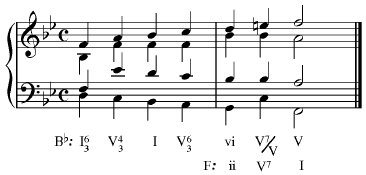
This example is similar to the previous one in that the penultimate chord is a V7 applied to the following V. However, listening carefully to the example reveals that the subdominant triad on the downbeat of measure 2 seems to function as a predominant to the following applied dominant—in other words, it’s ii in the key of F Major. The second measure, as a whole, sounds as though it is in F Major. What we actually have here is a short modulation which is approached by a chord acting as a pivot chord—the ‘vi’ of B-flat Major also functions as ii of F Major.
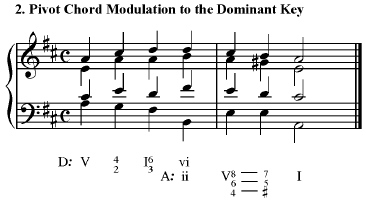
This is an example of a pivot chord modulation. The submediant is an excellent pivot chord, acting as it does as the predominant chord in the new key. The analytical notation indicates the change of key (A:), with the new key being written a row lower than the original key. Also note that the pivot chord is indicated clearly by marking the function for the chord both in the original key (vi) and the new key (ii).
Also note that the figures in the cadential 64 in measure 2 indicate the raised third of the chord. Even though we have modulated into A Major (where a G# is part of the key), the note requires being written with an accidental—and in figures, any accidental by a note is indicated with accidentals in the figures as well.
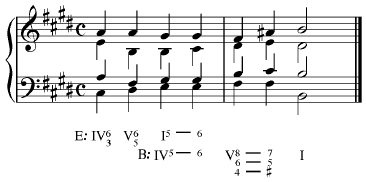
Here is the “5-6 Technique” applied to a pivot chord. Examine carefully the “I5-6” and note that the second chord of the pair could also be analyzed as vi6—which becomes ii6 in the new key.
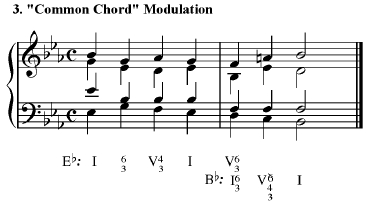
Some theoreticians refer to a chord which is common to both keys, but not a predominant in the new key, as a “common” chord. Most people refer to all chords common to both keys as pivot chords, however.
Note the analysis in this example: the penultimate chord has indicated the raised sixth above the bass with a slashed 6.
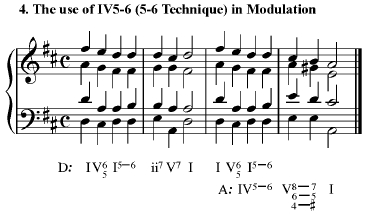
One more example of the “5-6 Technique” which allows us to see how a pivot chord can be used to move into a new key. In the first two measures, I5-6 is used solely as a preparation for ii7 and a cadence into the original tonic. In measures 3-4, the same chord is used to introduced a cadential 64 in the key of the dominant. The remainder of the chapter is devoted to the idea of modulation as an engine powering notions of form. The examples in the textbook are good for this usage, as are numerous (uncountable, really) examples from the literature. Another excellent source is the workbook—there are a fair number of pieces to analyze.